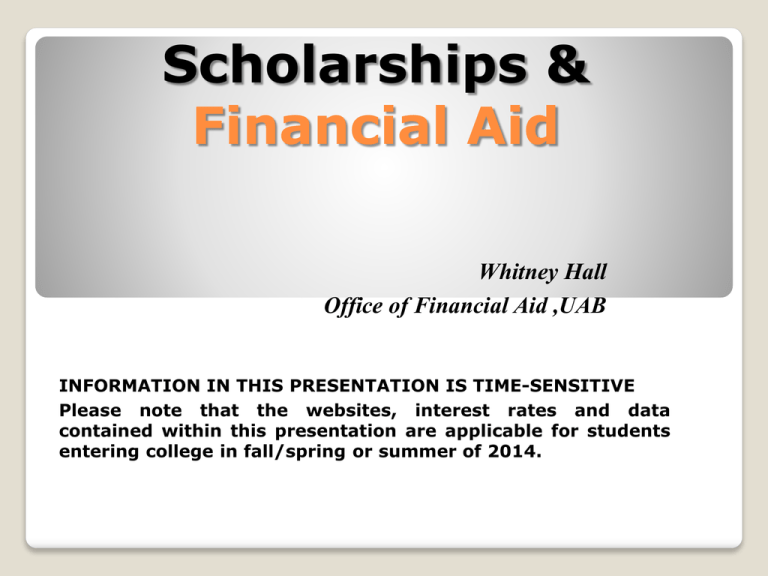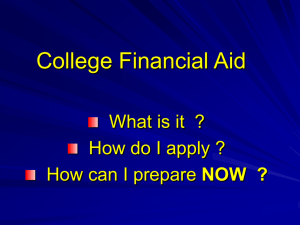Financial Aid
advertisement

Scholarships & Financial Aid Whitney Hall Office of Financial Aid ,UAB INFORMATION IN THIS PRESENTATION IS TIME-SENSITIVE Please note that the websites, interest rates and data contained within this presentation are applicable for students entering college in fall/spring or summer of 2014. SHOW ME THE MONEY! Where should I look for scholarships? What is Financial Aid? What is the FAFSA? What are the different types of aid? Who can I talk to? Start By Researching! Know EACH individual institution’s scholarship and financial aid criteria. Know about the scholarship/financial aid deadlines for EACH school you apply to. Know the cost of attendance (COA) for EACH institution. Know what you can afford. Research (continued) Outside scholarships sites: FastWeb.com CollegeBoard.org Petersons.com CollegeScholarships.org Local scholarships and loans Ask your guidance counselor Check with student and parent employer(s) Civic Organizations Credit Unions (they sometimes have very competitive interest rates on loans) Research (continued) Research scholarships and loans nationally. Special Interest Funds (i.e. Diabetes Scholars Fund, Food Allergy and Anaphylaxis Network, Coca-Cola Foundation, Bill & Melinda Gates Foundation) AmeriCorps– offers funding in exchange for community service Federal Student Aid USE GOOGLE (wisely)!! Scholarships at UAB Entering freshman are automatically considered for all university-wide academic scholarships as soon as they’re admitted. To be eligible for an academic scholarship at UAB, you must be admitted by December 1st of the prior year. What is the FAFSA? To be eligible for Federal Financial Aid (Pell Grant, SEOG, Perkins, Direct Stafford Loans and work-study), you MUST complete a FREE APPLICATION FOR FEDERAL STUDENT AID (FAFSA) Every FAFSA applicant is assigned an “EFC” or “Expected Family Contribution” by the Department of Education for Colleges/Universities to use when awarding Pell. What is the FAFSA ? (continued) Complete a FAFSA every year, even if you think you don’t qualify for federal aid. Upon completion, you will later receive an award letter from the college(s) listed on your application, giving amounts and types of loans/grants in your package. If necessary, you can make changes to an already submitted FAFSA by going back to the website. What is the FAFSA? ( continued) For the 2013-2014 school year, online applications must be submitted by June 30, 2014. For the 2014-2015 school year, you may begin completing a FAFSA as early as February, 2014. The IRS Data Retrieval Tool is available for students and parents who have filed a 2013 federal income tax return. FAFSA 4Caster Not ready to complete the REAL thing just yet? FAFSA4Caster is available for anyone who is not ready to file a FAFSA but would like to get an estimate of eligibility in financial aid. FAFSA4Caster is a FREE planning tool, NOT an actual application. www.federalstudentaid.ed.gov Different Types of Aid Loans ◦ Direct Subsidized Stafford loans The interest on a subsidized loan is paid by the government while you are in school and in periods of deferment . Interest rate is fixed at 3.86% ◦ Direct Unsubsidized Stafford Loans An Unsubsidized Stafford Loan is a federal loan that is not based on financial need. Interest will accrue from the time the loan is disbursed to the school. You do not have to make interest or principal payments until six months after graduation, or six months after you drop below a half time status. Interest rate is fixed at- 3.86% (accrues monthly). Different Types of Aid Direct Plus Loan ( Parent Plus loan) ◦ Direct Plus Loans are low-interest loans for students and parents to help pay for the cost of education. The interest rate is fixed at 6.41%. Private Loan ◦ Private loans are offered by private lenders and there are no federal forms to complete. Eligibility for private student loans often depends on your credit score. Institutional Loan ◦ Loans offered by the College or University you attend (Perkins). There are no loan fees for Perkins loans. Different Types of Aid Pell Grants Most families do not qualify for PELL grants. Students with a low EFC (estimated family contribution) are eligible for Pell. Do not be discouraged if you do not qualify for the Pell grant. Minimum PELL award amount to receive in a year is $605 Maximum PELL award amount is $5645 Different Types of Aid SEOG Grants Work Study Supplemental Educational Opportunity Grant (SEOG) is also a need-based program; priority for SEOG funds goes to students who also qualify for Pell. Federal Work Study provides part-time employment for eligible undergraduate and graduate students. Federal Work-Study is based on “demonstrated need” Why?? Because the salary is paid by both federal government sources (75%) AND from college/university resources (25%) Loan Re-payment & Deferment Repayment on BOTH types of Stafford loans begins 6 months after the student is no longer enrolled at least ½ time or upon graduation. The standard repayment plan is a fixed monthly payment for up to 10 years. Other repayment options are listed at www.direct.ed.gov. Loan Re-payment & Deferment A deferment is a postponement of payment on a loan, during which interest does not accrue if the loan is subsidized. Most student are automatically in deferment while enrolled at least half time at a eligible postsecondary school or studying full time in a graduate fellowship program or an approved disability rehabilitation program; unemployed or meet certain criteria for economic hardship (limited to 3 years). Who Can I Talk To? Your High School Guidance Counselors…Mrs. Berryhill, Mr. Keel, and Ms. Knight! An Admissions Counselor at the college of choice. A Financial Aid Counselor at the college of choice. Your PARENT(S)! Websites to Remember www.fafsa.gov www.direct.ed.gov www.federalstudentaid.ed.gov QUESTIONS???





